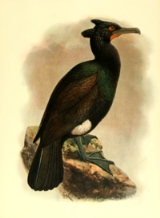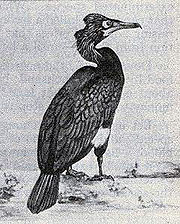
Spectacled Cormorant
Encyclopedia
The Spectacled Cormorant or Pallas's Cormorant (Phalacrocorax perspicillatus) is an extinct
marine bird
of the cormorant
family of seabird
s that inhabited Bering Island
and possibly other places in the Komandorski Islands
and the nearby coast of Kamchatka
. A presumed prehistoric record from Amchitka Island, Alaska
(Siegel-Causey et al., 1991), is based on misidentification of Double-crested Cormorant
remains (Olson, 2005). It was the largest species of cormorant
known to exist.
 The species was first identified by Georg Steller in 1741 on Vitus Bering
The species was first identified by Georg Steller in 1741 on Vitus Bering
's disastrous second Kamchatka expedition. He described the bird as large, clumsy and almost flightless — though it was probably reluctant to fly rather than physically unable — and wrote "they weighed 12 – 14 pounds, so that one single bird was sufficient for three starving men." Though cormorants are normally notoriously bad-tasting, Steller says that this bird tasted delicious, particularly when it was cooked in the way of the native Kamtchadals, who encased the whole bird in clay and buried it and baked it in a heated pit.
Apart from the fact that it fed on fish
, almost nothing else is known about this bird. The population declined quickly after further visitors to the area started collecting the birds for food and feather
s, and their reports of profitable whaling
grounds and large populations of Arctic fox
es and other animals with valuable pelts led to a massive influx of whalers and fur traders into the region; the last birds were reported to have lived around 1850 on Ariy Rock
islet, off the northwestern tip of Bering Island
.
Extinction
In biology and ecology, extinction is the end of an organism or of a group of organisms , normally a species. The moment of extinction is generally considered to be the death of the last individual of the species, although the capacity to breed and recover may have been lost before this point...
marine bird
Bird
Birds are feathered, winged, bipedal, endothermic , egg-laying, vertebrate animals. Around 10,000 living species and 188 families makes them the most speciose class of tetrapod vertebrates. They inhabit ecosystems across the globe, from the Arctic to the Antarctic. Extant birds range in size from...
of the cormorant
Cormorant
The bird family Phalacrocoracidae is represented by some 40 species of cormorants and shags. Several different classifications of the family have been proposed recently, and the number of genera is disputed.- Names :...
family of seabird
Seabird
Seabirds are birds that have adapted to life within the marine environment. While seabirds vary greatly in lifestyle, behaviour and physiology, they often exhibit striking convergent evolution, as the same environmental problems and feeding niches have resulted in similar adaptations...
s that inhabited Bering Island
Bering Island
Bering Island is located off the Kamchatka Peninsula in the Bering Sea. At long by wide, it is the largest of the Commander Islands with the area of ....
and possibly other places in the Komandorski Islands
Komandorski Islands
Commander Islands or Komandorski Islands are a group of treeless Russian islands located east of the Kamchatka Peninsula in the Russian Far East, in the Bering Sea...
and the nearby coast of Kamchatka
Kamchatka Peninsula
The Kamchatka Peninsula is a peninsula in the Russian Far East, with an area of . It lies between the Pacific Ocean to the east and the Sea of Okhotsk to the west...
. A presumed prehistoric record from Amchitka Island, Alaska
Alaska
Alaska is the largest state in the United States by area. It is situated in the northwest extremity of the North American continent, with Canada to the east, the Arctic Ocean to the north, and the Pacific Ocean to the west and south, with Russia further west across the Bering Strait...
(Siegel-Causey et al., 1991), is based on misidentification of Double-crested Cormorant
Double-crested Cormorant
The Double-crested Cormorant is a member of the cormorant family of seabirds. It occurs along inland waterways as well as in coastal areas, and is widely distributed across North America, from the Aleutian Islands in Alaska down to Florida and Mexico...
remains (Olson, 2005). It was the largest species of cormorant
Cormorant
The bird family Phalacrocoracidae is represented by some 40 species of cormorants and shags. Several different classifications of the family have been proposed recently, and the number of genera is disputed.- Names :...
known to exist.
Discovery

Vitus Bering
Vitus Jonassen Bering Vitus Jonassen Bering Vitus Jonassen Bering (also, less correNavy]], a captain-komandor known among the Russian sailors as Ivan Ivanovich. He is noted for being the first European to discover Alaska and its Aleutian Islands...
's disastrous second Kamchatka expedition. He described the bird as large, clumsy and almost flightless — though it was probably reluctant to fly rather than physically unable — and wrote "they weighed 12 – 14 pounds, so that one single bird was sufficient for three starving men." Though cormorants are normally notoriously bad-tasting, Steller says that this bird tasted delicious, particularly when it was cooked in the way of the native Kamtchadals, who encased the whole bird in clay and buried it and baked it in a heated pit.
Apart from the fact that it fed on fish
Fish
Fish are a paraphyletic group of organisms that consist of all gill-bearing aquatic vertebrate animals that lack limbs with digits. Included in this definition are the living hagfish, lampreys, and cartilaginous and bony fish, as well as various extinct related groups...
, almost nothing else is known about this bird. The population declined quickly after further visitors to the area started collecting the birds for food and feather
Feather
Feathers are one of the epidermal growths that form the distinctive outer covering, or plumage, on birds and some non-avian theropod dinosaurs. They are considered the most complex integumentary structures found in vertebrates, and indeed a premier example of a complex evolutionary novelty. They...
s, and their reports of profitable whaling
Whaling
Whaling is the hunting of whales mainly for meat and oil. Its earliest forms date to at least 3000 BC. Various coastal communities have long histories of sustenance whaling and harvesting beached whales...
grounds and large populations of Arctic fox
Arctic fox
The arctic fox , also known as the white fox, polar fox or snow fox, is a small fox native to Arctic regions of the Northern Hemisphere and is common throughout the Arctic tundra biome. The Greek word alopex, means a fox and Vulpes is the Latin version...
es and other animals with valuable pelts led to a massive influx of whalers and fur traders into the region; the last birds were reported to have lived around 1850 on Ariy Rock
islet, off the northwestern tip of Bering Island
Bering Island
Bering Island is located off the Kamchatka Peninsula in the Bering Sea. At long by wide, it is the largest of the Commander Islands with the area of ....
.
External links
- 3D view of specimen RMNH 107.865 at NaturalisNaturalisNaturalis is the national natural history museum of the Netherlands, based in Leiden. It originated from the merger of the Rijksmuseum van Natuurlijke Historie and the Rijksmuseum van Geologie en Mineralogie in 1984. In 1986 it was decided that the museum had to become a public museum and a new...
, Leiden (requires QuickTimeQuickTimeQuickTime is an extensible proprietary multimedia framework developed by Apple Inc., capable of handling various formats of digital video, picture, sound, panoramic images, and interactivity. The classic version of QuickTime is available for Windows XP and later, as well as Mac OS X Leopard and...
browser plugin).

